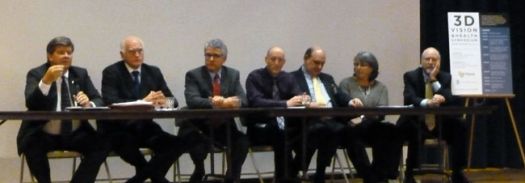Over the past couple of years, we've heard producers, directors, animators and consumer electronics manufacturers all weigh in on the topic of 3D... but what about the real experts? This week at the exclusive 3D Vision and Health Symposium at the State University of New York College of Optometry, prominent eye doctors and other noted specialists cast their two cents about 3D.
The distinguished panelists included Michael Duenas, OD, American Optometric Association; Jim Sheedy, OD, PhD, Vision Performance Institute of Pacific University; Chris Haws, Psychologist and 3D Filmmaker, who gave us all a wonderfully entertaining history of 3D; Philip Corriveau form Intel Labs; and Heidi Hoffman of the 3D@Home Consortium. They were later joined for the Q&A by AOA President Dr. Joe Ellis and Rick Dean, Senior VP of THX and Chairman of 3D@Home. The 3D@Home Consortium represents close to 50 different member companies from all aspects of the 3D industry, including production, distribution and consumer products.
Somewhat surprisingly for this largely consumer electronics-based audience, the gang introduced the topic of public safety implications and the use of 3D as a means to protect eye health. How's that, exactly? Turns out that society as a whole, and children in particular, are not receiving proper eye care. By missing out on proper screening and treatment early in life, vision problems which could be corrected at a young age, can turn into life long conditions, difficult or impossible to correct later in life. And these vision problems can lead to difficulties in reading and learning, which can in turn not only compromise their quality of life but actually increase their chances of becoming a juvenile delinquent.
An estimated ten to 20% of people cannot see 3D, and this symptom can be a warning sign of eye disease. Exposing kids aged 6 or younger to 3D could bring about early detection, and the sooner vision problems are diagnosed, the more likely they are to be successfully addressed. If a child looks uncofortable when viewing 3D TV or a 3D gaming console or says "it looks flat" or "it looks fuzzy" these could actually be warning signs of eye disorders that may be treatable at a young age via patching or corrective lenses before the condition worsens. So, could Nintendo's safety warning on their upcoming 3DS portable gaming system be unnecessary? The doctors seem to agree that the variety of health concerns surrounding 3D appear to lack a strong scientific basis, and sound more like manufacturers (and their lawyers) trying to cover their collective butts.

We were also reminded that movies and TV represent "virtual 3D," a controversial term to some but one that addresses how we perceive depth in video and film. This is different from the three dimensions we see in the real world, truly stereoscopically with monocular depth cues and the disparity of these two non-identical images--owing to the approximately two-and-a-half inches between our eyes-- translated by our brains to a "sensation of depth." Virtual 3D technology by comparison uses our eyes in a unique way. The docs say that the current technology is good but could be better, although 3D is also quietly revolutionizing science and medicine, especially the ways in which tomorrow's specialists are training today.
3D Microsurgery is one example: 3D cameras and displays allow a surgeon to perform precise surgeries with extremely fine detail, courtesy of real-time 3D imaging systems. In some cases, doctors don't have to be in the same room, or even in the same country to perform surgeries remotely via precise robotic tools. The military is another arena where virtual 3D imaging is becoming more important. Why put a person in harm's way when a 3D-equipped robot could just as easily diffuse a dealy device? Those who cannot see in 3D cannot even consider performing these tasks.

At the event, 3D@Home and the AOA signed a "Memorandum of Understanding," formally stating their intent to share pertinent data in an effort to jointly promote vision health and to investigate any potential health risks caused by using stereoscopic 3D displays.
Of course, no 3D event would be complete without dropping the A-word, and another sports announcement. We were reminded that Avatar's record-setting $2B+ global gross is proof-positive that 3D is "not just a fad." The Na'vi will soon be reinforced by dozens of other 3D movies currently in production, and the one million 3D-ready TVs sold in the United States alone last year, out of 3.5 million worldwide, send a pretty strong message as well. Sony, meanwhile, will be bringing us Wimbledon in 3D this year for the first time.
And no expert from any corner of the 3D world can resist grumbling about the lack of universal standard. They're all for a quality 3D experience, across multiple devices, and so the consensus is that autostereoscopic 3D (sans glasses) is further away from reality than most people expect. But since so many people already wear eyeglasses and sunglasses so much of the time, do two more hours of wearing glasses pose such a hardship?
Which led to one final audience question, right under the wire: "What are the adverse effects of virtual 3D viewing on the eyes?" The doctors are seriously investigating it, but they insist that right now they have found no reason to suspect harm! Which is good news for me as I head off to review more Blu-ray 3D discs....
More Information: